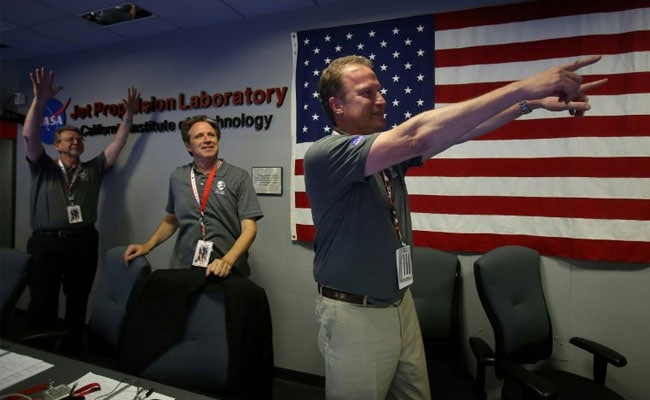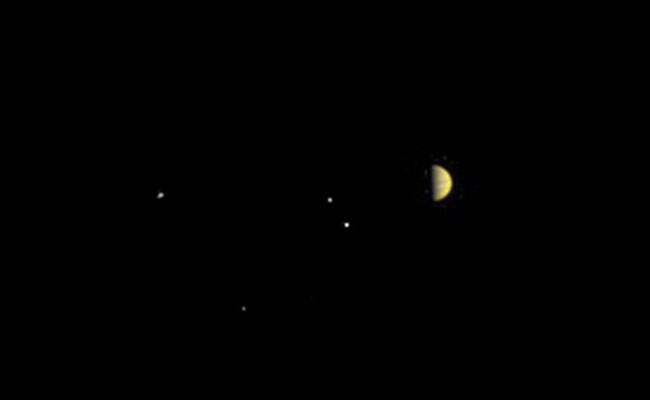
- NASA's unmanned spacecraft, Juno, successfully enters Jupiter's orbit
- The mission aims to uncover origins of the solar system's biggest planet
- The mission cost $1.1 billion dollars and was launched five years ago
"Welcome to Jupiter," said a commentator at mission control at NASA's Jet Propulsion Laboratory in Pasadena, California.
Braving intense radiation, the NASA spacecraft reached Jupiter after a five-year voyage to begin exploring the king of the planets.
The spacecraft's camera and other instruments were switched off for arrival, so there won't be any pictures at the moment it reaches its destination. Hours before the encounter, NASA released a series of images taken last week during the approach, showing Jupiter glowing yellow in the distance, circled by its four inner moons.
The room erupted in cheers as the solar observatory successfully entered its aimed-for orbit around Jupiter at 11:53 pm (0353 GMT Tuesday).
NASA's Juno mission's official twitter handle tweeted:
Success! Engine burn complete. #Juno is now orbiting #Jupiter, poised to unlock the planet's secrets. https://t.co/YFsOJ9YYb5
— NASA (@NASA) July 5, 2016
When the engine began to roar, the handle had tweeted:
Main engine burn is go. I'm burnin', burnin', burnin' for you, #Jupiter. pic.twitter.com/b3SHm3Gphj
- NASA's Juno Mission (@NASAJuno) July 5, 2016
The spacecraft has traveled 1.7 billion miles (2.7 billion kilometers) since it launched five years ago from Cape Canaveral, Florida.
"We are in it," hollered Scott Bolton, NASA's principal investigator.
"You are the best team ever," he told his colleagues at mission control.
"You just did the hardest thing NASA has ever done."
Scientists have promised close-up views of the planet when Juno skims the cloud tops during the 20-month, $1.1 billion mission.
The fifth rock from the sun and the heftiest planet in the solar system, Jupiter is what's known as a gas giant - a ball of hydrogen and helium - unlike rocky Earth and Mars.
With its billowy clouds and colorful stripes, Jupiter is an extreme world that likely formed first, shortly after the sun. Unlocking its history may hold clues to understanding how Earth and the rest of the solar system developed.
Named after Jupiter's cloud-piercing wife in Roman mythology, Juno is only the second mission designed to spend time at Jupiter.
Galileo, launched in 1989, circled Jupiter for nearly a decade, beaming back splendid views of the planet and its numerous moons. It uncovered signs of an ocean beneath the icy surface of the moon Europa, considered a top target in the search for life outside Earth.
Juno's mission: To peer through Jupiter's cloud-socked atmosphere and map the interior from a unique vantage point above the poles.
Among the lingering questions: How much water exists? Is there a solid core? Why are Jupiter's southern and northern lights the brightest in the solar system?

A 1/5th size scale model of NASA's Juno spacecraft is displayed at the Jet Propulsion Laboratory in Pasadena, California, July 4, 2016. (AFP Photo)
There's also the mystery of its Great Red Spot. Recent observations by the Hubble Space Telescope revealed the centuries-old monster storm in Jupiter's atmosphere is shrinking.
The trek to Jupiter, spanning nearly five years and 1.8 billion miles (2.8 billion kilometers), took Juno on a tour of the inner solar system followed by a swing past Earth that catapulted it beyond the asteroid belt between Mars and Jupiter.

Rick Nybakken, Juno project manager, Scott Bolton, NASA principal investigator for the Juno mission react as the Juno spacecraft successfully enters Jupiter's orbit. (AFP Photo)
Along the way, Juno became the first spacecraft to cruise that far out powered by the sun, beating Europe's comet-chasing Rosetta spacecraft. A trio of massive solar wings sticks out from Juno like blades from a windmill, generating 500 watts of power to run its nine instruments.
In the coming days, Juno will turn its instruments back on, but the real work won't begin until late August when the spacecraft swings in closer. Plans called for Juno to swoop within 3,000 miles (5,000 kilometers) of Jupiter's clouds - closer than previous missions - to map the planet's gravity and magnetic fields in order to learn about the interior makeup.

NASA's Juno spacecraft obtained this color view at a distance of 6.8 million miles (10.9 million kilometers) from Jupiter. (Reuters Photo)
Like Galileo before it, Juno meets its demise in 2018 when it deliberately dives into Jupiter's atmosphere and disintegrates - a necessary sacrifice to prevent any chance of accidentally crashing into the planet's potentially habitable moons.
Track Latest News Live on NDTV.com and get news updates from India and around the world

